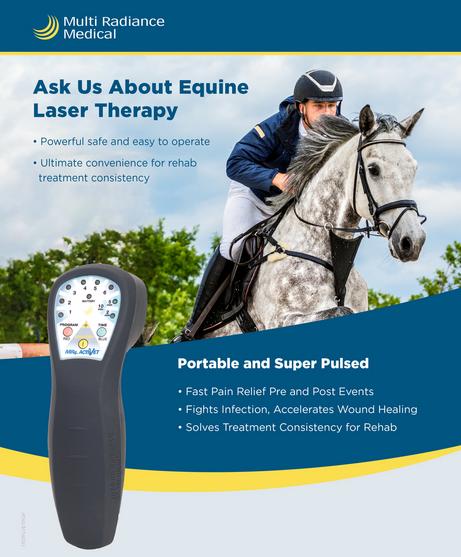Equine Therapy for Injury Recovery: Exactly How Equines Help Heal Emotional Wounds
Equine Therapy for Injury Recovery: Exactly How Equines Help Heal Emotional Wounds
Blog Article
Laser Therapy in Equine Therapy: A Modern Approach to Improving Horse Wellness
Laser treatment has emerged as a pivotal strategy in equine treatment, utilizing focused light energy to cultivate cellular repair work and accelerate recovery from a variety of ailments. This non-invasive approach is especially efficient in handling bone and joint injuries, injuries, and inflammatory problems, dramatically boosting general steed wellness. By stimulating mitochondrial task and increasing ATP production, laser treatment not only improves flow but additionally offers substantial discomfort alleviation. As this innovative therapy remains to acquire grip, it opens up fascinating opportunities for dealing with chronic conditions like joint inflammation and unguis troubles, signifying a transformative change in veterinary care. What makes this technique particularly engaging?
Understanding Laser Therapy
Laser therapy, a non-invasive treatment technique, has obtained significant traction in equine medicine due to its efficiency in advertising healing and pain relief. This innovative restorative technique uses concentrated light energy to pass through tissues, fostering mobile fixing and regrowth. The underlying device involves the excitement of cellular mitochondria, resulting in enhanced production of adenosine triphosphate (ATP), the power money of cells. Enhanced ATP degrees expedite cells fixing processes and lower swelling, making laser treatment particularly effective for treating bone and joint injuries, wounds, and various other inflammatory conditions in equines.
There are a number of kinds of lasers utilized in equine therapy, each with specific wavelengths and power results tailored to different restorative needs. Low-level laser treatment (LLLT), likewise called cold laser therapy, uses lower power degrees to boost cell feature without causing thermal damage. High-intensity laser treatment (HANDLE), in contrast, utilizes greater power degrees to accomplish deeper cells penetration and more considerable restorative impacts.
Veterinarians use different laser gadgets and methods depending on the condition being treated and the wanted deepness of tissue penetration. Appropriate training and proficiency are critical for making certain the safe and effective application of laser therapy, thereby optimizing its restorative possibility while reducing dangers.
Benefits for Horse Health
With a strong understanding of just how laser therapy works, it is very important to discover its countless advantages for equine wellness. Among the main benefits is its ability to speed up tissue fixing and cell growth. By boosting cellular function, laser treatment advertises faster injury healing and help in the regrowth of damaged cells. This can be specifically helpful in minimizing healing times for steeds experiencing injuries.
Furthermore, laser therapy has been revealed to enhance flow, thus improving blood flow to impacted locations. Boosted flow guarantees that essential nutrients and oxygen are supplied more effectively, facilitating the healing procedure. Furthermore, laser treatment's anti-inflammatory effects aid in lowering swelling and discomfort, which is essential for the total well-being of the equine.
Discomfort management is one more considerable advantage. By releasing endorphins and blocking discomfort signals, laser treatment gives efficient, non-invasive alleviation from both acute and persistent pain. This can contribute to enhanced mobility and quality of life for the animal.
Last but not least, laser treatment is a non-invasive treatment alternative, minimizing the danger of problems linked with even more intrusive procedures. Its adaptability and effectiveness make it an important tool in modern-day horse veterinary medicine.
Common Conditions Treated

An their explanation additional common condition treated with laser therapy is joint inflammation. Horses dealing with both intense and persistent joint inflammation gain from the anti-inflammatory impacts of laser therapy, which helps to ease discomfort and improve joint feature. Additionally, laser therapy is employed in the monitoring of injuries. Whether dealing with surgical cuts or distressing injuries, the method advertises quicker cells repair work and minimizes the risk of infection.
Horse respiratory system conditions, Related Site such as recurring air passage obstruction (RAO), likewise react positively to laser therapy. Laser treatment is valuable in treating hoof troubles, including laminitis and abscesses.
Treatment and Safety
Carrying out laser therapy in equine treatment involves a thorough treatment to ensure both efficiency and safety. Equine Therapy. The process begins with a complete veterinary analysis to establish the viability of laser treatment for the horse's details condition. As soon as considered suitable, the treatment area is prepared by cleaning and, if essential, clipping the hair to enhance laser penetration
The practitioner must choose the appropriate kind of laser, normally a low-level laser (LLLT) or a high-power laser (HPL), depending on the problem being treated. The laser device is after that adjusted to the ideal wavelength, power, and period setups. During the application, the expert moves the laser over the targeted area in a systematic way, making sure constant and even exposure.
Safety and security protocols are strictly abided by, including the usage of protective glasses for both the professional and the steed. In addition, it is essential to keep an eye on the equine for any signs of pain or adverse responses throughout the treatment. Post-treatment, the steed is frequently provided a duration of remainder to enable the healing results to show up.

Future of Equine Laser Therapy
As developments in vet medication proceed to unravel, the future of equine laser treatment holds considerable promise. Arising modern technologies and much deeper scientific understandings are set to refine and increase the applications of laser therapy for horses.
In addition, recurring research study into the go to these guys molecular and mobile devices of laser treatment will likely produce enhanced protocols tailored to certain problems, boosting performance and decreasing therapy times. Personalized treatment strategies based upon genetic and biochemical markers can come true, making certain that each equine receives the most suitable and reliable treatment.
In addition, regulatory innovations and standardization of protocols will certainly enhance the trustworthiness and reliability of laser therapy in equine practice. Equine Therapy. As these innovations continue to arise, equine laser therapy is positioned to become a vital component of vet care, offering enhanced recovery and improved quality of life for horses globally
Conclusion

Report this page